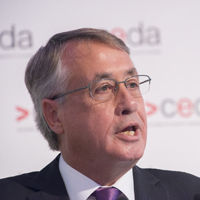
The unusually high Australian dollar has given the export economy a beating, leaving the government no choice but to take a softly-softly approach to rebalancing the Federal Budget, Deputy Prime Minister and Treasurer Wayne Swan has told a CEDA forum in Brisbane.
Mr Swan said Australia had experienced a once in 50-year event in the early months of 2013 where, for the first time for three quarters in a row, nominal GDP growth fell below real GDP growth.
That is, the Australian dollar remained very high despite falling terms of trade and lower interest rates, squeezing the profitability of companies right across the economy, he said.
"We haven't had a problem on our spending side, despite everybody continuing to write that in the papers, we've had a problem on our revenue side", he said.
"Our tax to GDP ratio is 21.5. When we came to government it was 23.7. If we had the tax to GDP ratio that we inherited from the previous government, we'd have $24 billion more this year and be in surplus."
While the high dollar had given many businesses more incentive to boost productivity and tap into new emerging markets, it had hit profits hard in the import-competing manufacturing and retail sectors, putting downward pressure on prices and forcing companies to absorb increases in costs, he said.
"Over the past year, we've seen this (high dollar) contribute to a 16 per cent decline in manufacturing profits and retail profits growing at a very subdued 1.9 per cent - well below their 10-year average of 6.5 per cent," he said.
"When you consider that manufacturing and retail are the fourth and sixth largest taxpayers by sector, it's not hard to see why the hit to profits they've taken has had such a huge impact on government revenues and of course, on those businesses."
Trade-exposed firms were also choosing to buy less or pay less to suppliers and service providers which, in turn, was affecting prices and profitability along the supply chain and compounding the government revenue hit, he said.
"In response to the second largest revenue write-down since the Great Depression, the government had to make some defining choices... to support jobs and growth and business by bringing the budget back to surplus on a responsible timeframe given these conditions," he said.
"We made the choice to keep our public finances strong through $43 billion of savings, for a total of $180 billion of savings over six years.
"We had many more moving parts than we would normally have and in an election year. It is not an election budget but it is a budget that is right for the times," he said.
The budget was appropriate given the significant contraction of about 1.7 per cent in 2012-13 and the profit squeeze, Mr Swan said. Fiscal policy was not an end in itself but a strong budget meant having the capacity to support the economy and invest for the future, he said.
"What this budget demonstrates is that you don't have to slash and burn to keep your budget strong over time and of course this was acknowledged on budget night by the three global agencies that confirmed our Triple A rating with a stable outlook - something that has never occurred before," Mr Swan said.
"As our economy rebalances in the short term, we've got to keep making investments for the long term," he said.
"Queensland, like the country, is in a prime position to capture the possibilities of the Asian Century as the global economy moves further towards our region - that movement of the global economy from west to east."
The strategy included continuing investment in productive infrastructure such as the:
Joint project with the Queensland Government to develop the Cross River Rail project, almost doubling the capacity of Brisbane's suburban rail network; and
The $4.1 billion, 10-year investment to upgrade the Bruce Highway.
Mr Swan said the government had also implemented structural savings, such as protecting the corporate tax base from erosion, reduced family payments, targeting health expenses and R&D expenses. This would improve the bottom line by over $300 billion by the end of the decade and fund priority investments in schools reform and disability care, Mr Swan said.
There would be some "bumps" as the mining investment boom shifted to the less labour intensive export phase and lower interest rates started to flow through to better activity in the property sector, he said.
However, "a slash and burn approach" would put Australian growth and jobs at risk, he said.
"What we see now is a very clear choice for Australia. We can yield to the atmosphere of panic whipped up by all of the fiscal fear-mongers and drive our economy into the ground or we can put in place a responsible fiscal policy that makes the investments for the future and comes back to surplus on a sustainable basis," he said.
"That is the responsible path ahead and that is the path contained in the budget, making investments for the future that will boost productivity and participation and make us a smarter and fairer society."